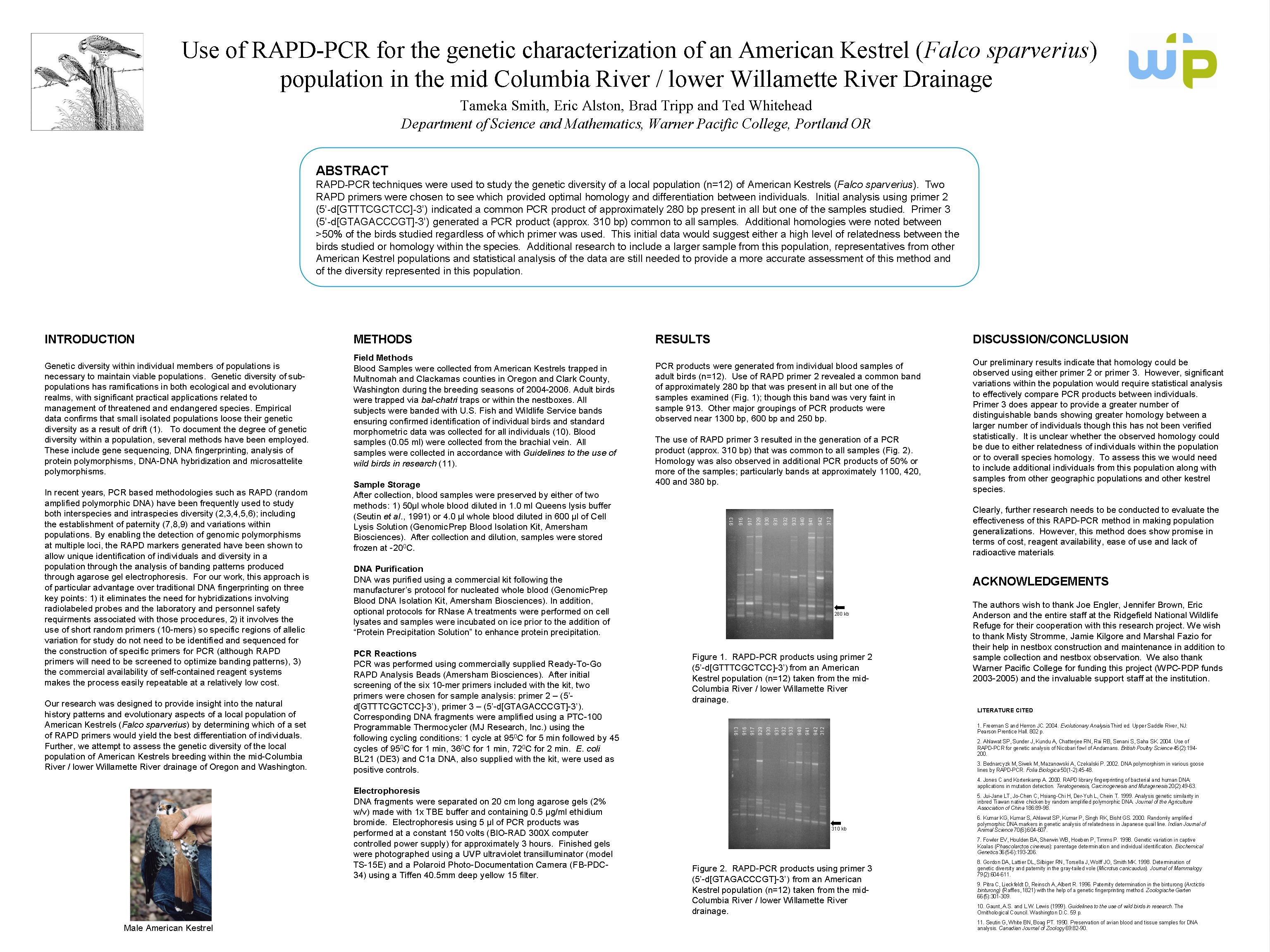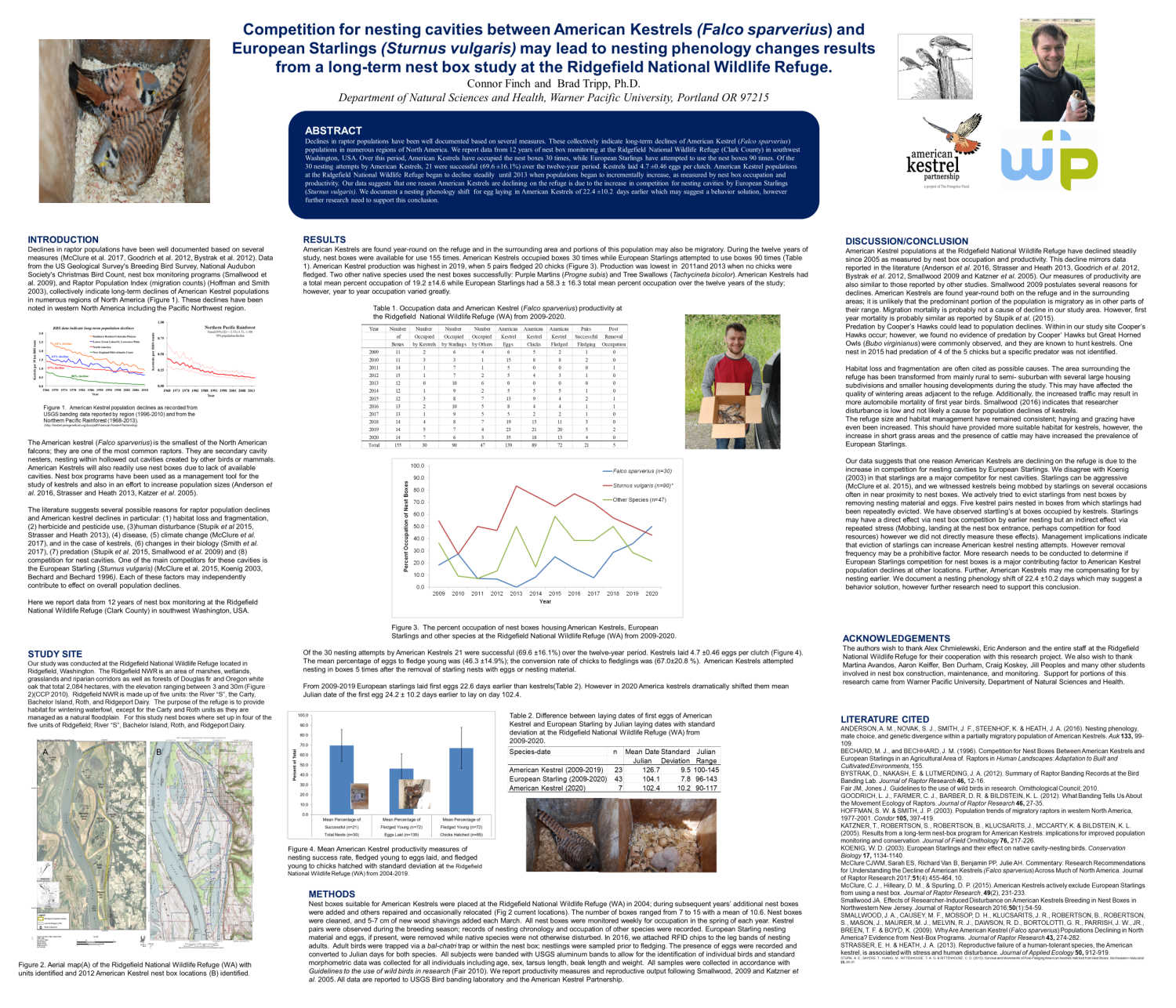 this conclusion.
this conclusion. Research Presentations
Competition for nesting cavities between American Kestrels Falco sparverius) and European Starlings (Sturnus vulgaris)
may lead to nesting phenology changes results from a long-term nest box study at the Ridgefield National Wildlife Refuge
(Murdock College Science Research Program Conference November 2012 Virtual Conference)
Connor Finch and Brad Tripp, Ph.D. Department of Natural Sciences and Health, Warner Pacific University, Portland OR 97215 (Click here for a downloadable pdf)TRACT
ABSTRACT
Declines in raptor populations have been well documented based on several measures. These collectively indicate long-term declines of American Kestrel (Falco sparverius) populations in numerous regions of North America. We report data from 12 years of nest box monitoring at the Ridgefield National Wildlife Refuge (Clark County) in southwest Washington, USA. Over this period, American Kestrels have occupied the nest boxes 30 times, while European Starlings have attempted to use the nest boxes 90 times. Of the 30 nesting attempts by American Kestrels, 21 were successful (69.6 ±16.1%) over the twelve-year period. Kestrels laid 4.7 ±0.46 eggs per clutch. American Kestrel populations at the Ridgefield National Wildlife Refuge began to decline steadily until 2013 when populations began to incrementally increase, as measured by nest box occupation and productivity. Our data suggests that one reason American Kestrels are declining on the refuge is due to the increase in competition for nesting cavities by European Starlings (Sturnus vulgaris). We document a nesting phenology shift for egg laying in American Kestrels of 22.4 ±10.2 days earlier which may suggest a behavior solution, however further research needed.. t
o support  this conclusion.
this conclusion.
Competition for nesting cavities between the American Kestrel (Falco sparverius) and European Starlings (Sturnus vulgaris) results from a long-term nest box study at the Ridgefield National Wildlife Refuge
(Murdock College Science Research Program Conference November 2019 Vancouver WA)
Martina Avendano and Brad Tripp, Ph.D. Department of Natural Sciences and Health, Warner Pacific University, Portland OR 97215 (Click here for a downloadable pdf)
ABSTRACT
Declines in raptor populations have been well documented based on several measures. These collectively indicate long-term declines of American Kestrel (Falco sparverius) populations in numerous regions of North America. We report data from 16 years of nest box monitoring at the Ridgefield National Wildlife Refuge (Clark County) in southwest Washington, USA. Over this period, American Kestrels have occupied the nest boxes 41 times, while European Starlings have attempted to use the nest boxes 90 times. Of the 41 nesting attempts by American Kestrels, 31 were successful (70.9±17.0 %) over the sixteen-year period. Kestrels laid 4.6 ±0.87 eggs per box. American Kestrel populations at the Ridgefield National Wildlife Refuge began to decline steadily in 2005 until 2013 when populations began to incrementally increase, as measured by nest box occupation and productivity. Our data suggests that one reason American Kestrels are declining on the refuge is due to the increase in competition for nesting cavities by European Starlings (Sturnus vulgaris). Management implications indicate eviction of starlings can increase American kestrel nest box use.
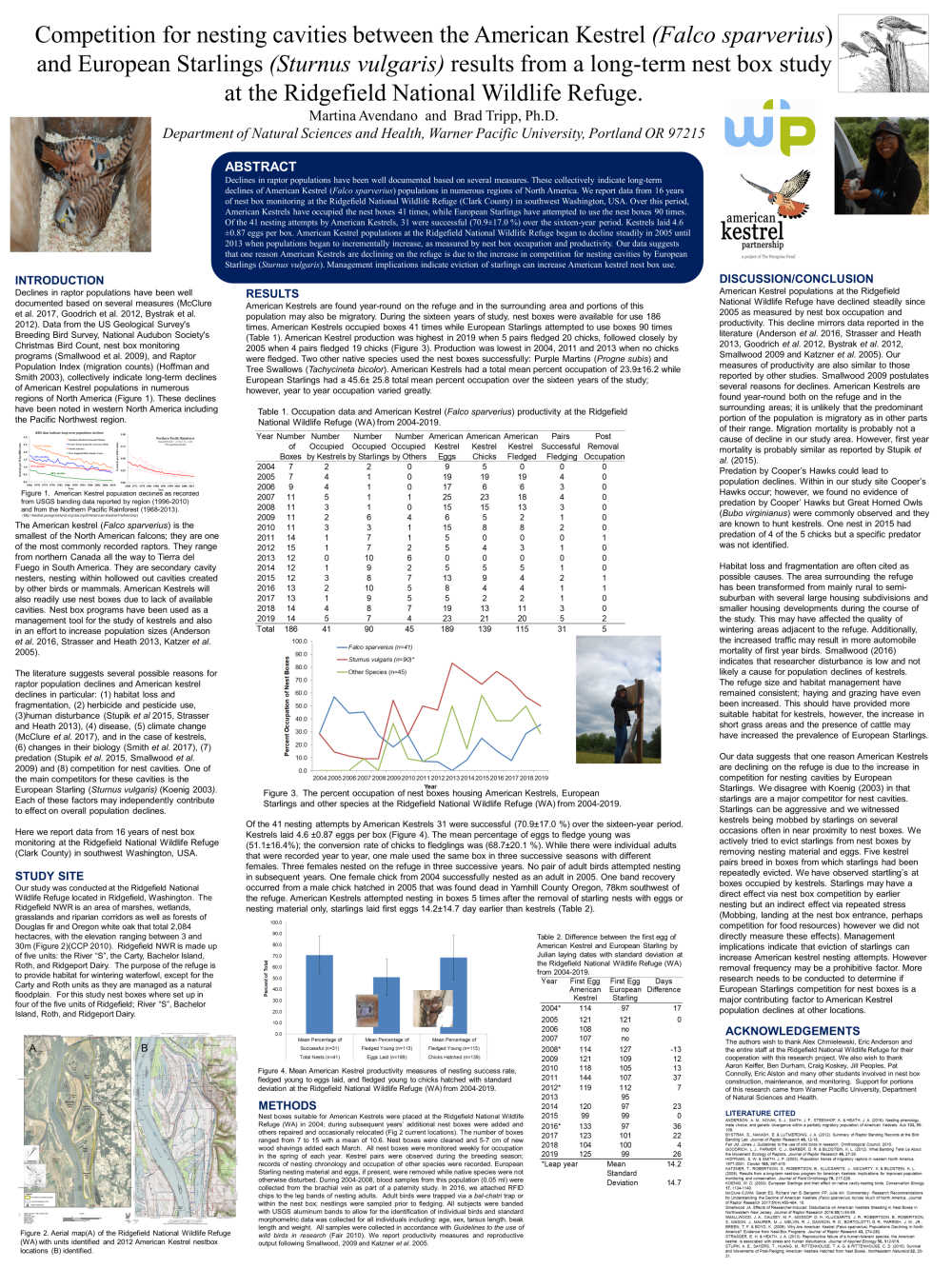
Competition may lead to declines in American Kestrel (Falco sparverius) nest box use at the Ridgefield National Wildlife Refuge and its implications for management.
Ben Durham and Brad Tripp Department of Natural Sciences and Health, Warner Pacific College, Portland OR (Click here for a downloadable pdf)
(Murdock College Science Research Program Conference November 4-5, 2016 Spokane WA )
Abstract
Declines in raptor populations have been well documented based on several measures. These collectively indicate long-term declines of American Kestrel (Falco sparverius) populations in numerous regions of North America. We report data from nine years of nest box monitoring at the Ridgefield National Wildlife Refuge (Clark County) in southwest Washington, USA. American Kestrels occupied boxes 31 times while European Starlings attempted to use boxes 66 times over this period. Of the 31 nesting attempts by American Kestrels 22 were successful (65.7 %) over the thirteen year period. Kestrels laid 4.5 ±0.96 eggs per box. American Kestrel populations at the Ridgefield National Wildlife Refuge have declined steadily since 2005 as measured by nest box occupation and productivity. Our data suggests that one reason American Kestrels are declining on the refuge is due to the increase in competition for nesting cavities by European Starlings (Sturnus vulgaris). Management implications indicate eviction of starlings can increase American kestrel nesting attempts.
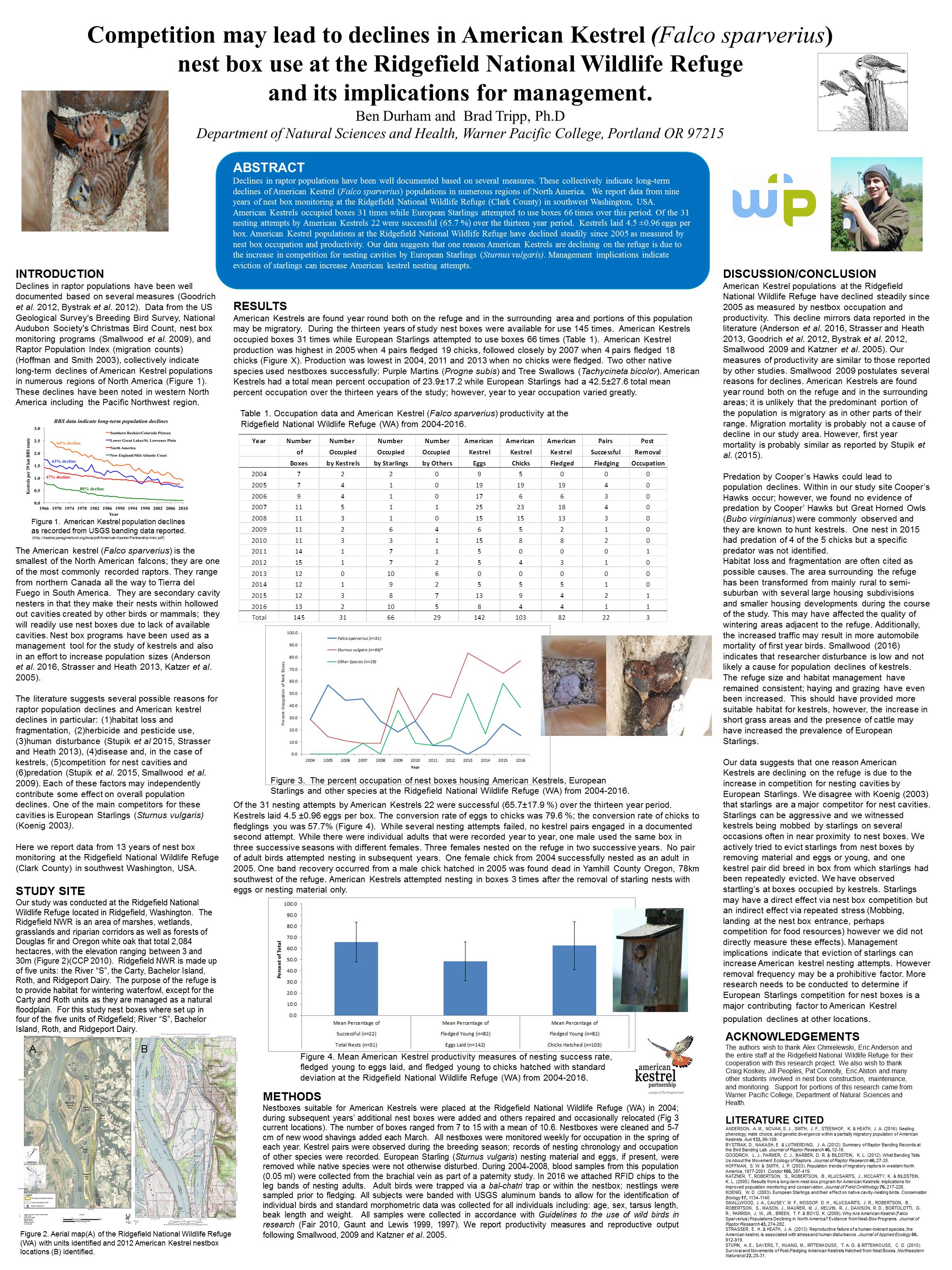
Decline of American Kestrel (Falco sparverius) populations at the Ridgefield National Wildlife Refuge mirrors national trends
Craig Koskey and Brad Tripp Department of Natural Sciences and Health, Warner Pacific College, Portland OR (Click here for a downloadable pdf)
Abstract
Declines in raptor populations have been well documented based on several measures. These collectively indicate long-term declines of American Kestrel (Falco sparverius) populations in numerous regions of North America. We report data from nine years of nestbox monitoring at the Ridgefield National Wildlife Refuge (Clark County) in southwest Washington, USA. American Kestrels occupied boxes 25 times while European Starlings attempted to use boxes 29 times over this period. Of the 25 nesting attempts by American Kestrels 18 were successful (67.2 %) over the nine year period. Kestrels laid 4.6 ±0.6 eggs per box. American Kestrel populations at the Ridgefield National Wildlife Refuge have declined steadily since 2005 as measured by nestbox occupation and productivity. Our limited data suggests that one reason American Kestrels are declining on the refuge is due to the increase in competition for nesting cavities by European Starlings (Sturnus vulgaris).
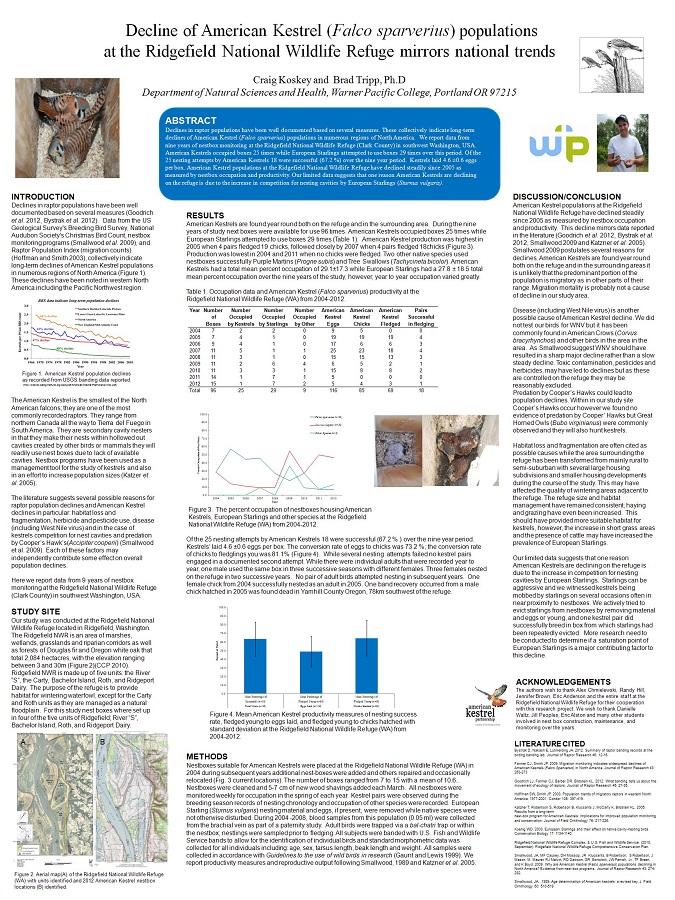
.
Determining genetic monogamy in American Kestrels (Falco sparverius) via RAPD-PCR DNA fingerprinting
Eric Alston, Tameka Smith, Ted Whitehead and Brad Tripp Department of Science and Mathematics, Warner Pacific College, Portland OR (Click here for a downloadable pdf)
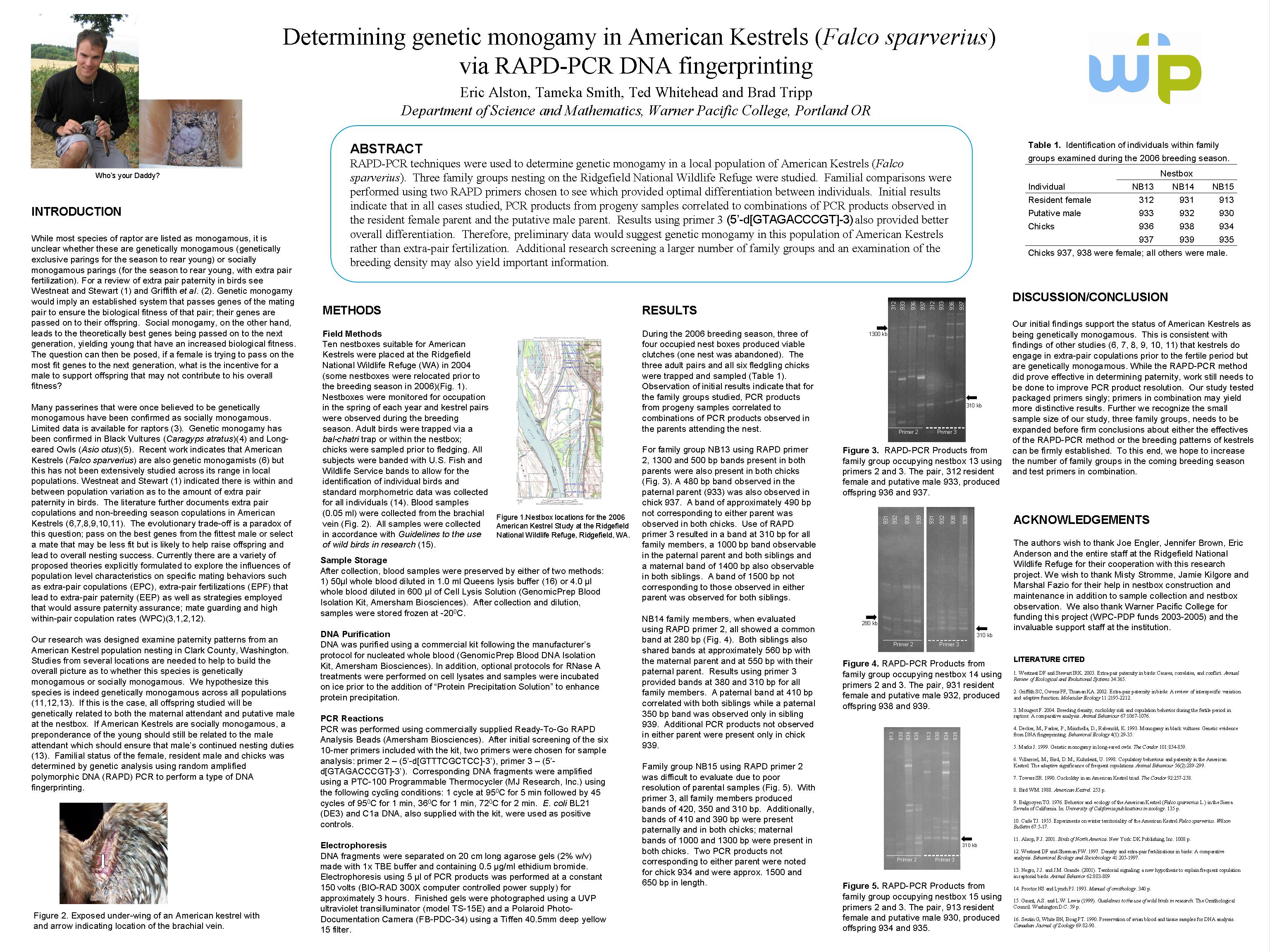
Use of RAPD-PCR for the genetic characterization of an American Kestrel (Falco sparverius) population in the mid Columbia River / lower Willamette River Drainage
Tameka Smith, Eric Alston, Brad Tripp and Ted Whitehead Department of Science and Mathematics, Warner Pacific College, Portland OR (Click here for a downloadable pdf)
